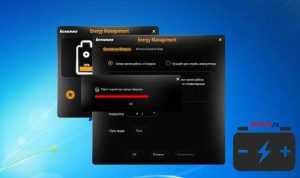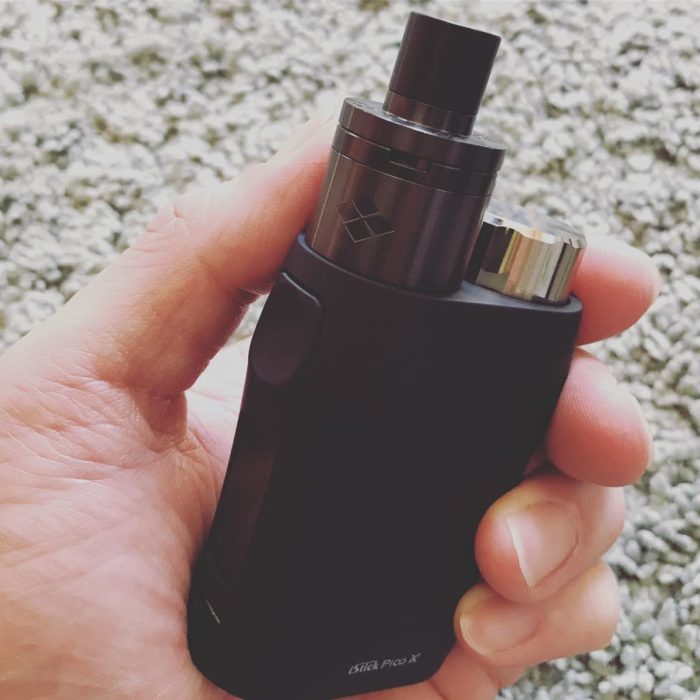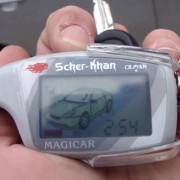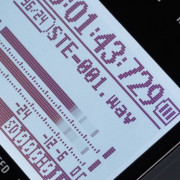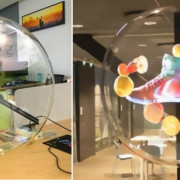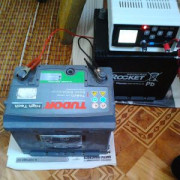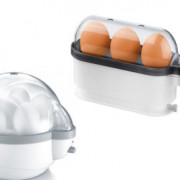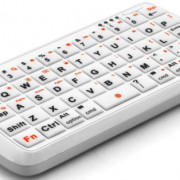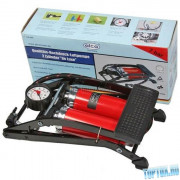Hg2
Содержание:
Overview
Ever since we posted a review of the LG HG2 battery, we have been asked the same question over and over- «how can I tell if my HG2 is fake?»
It is a good question to ask indeed, as we have identified a seemingly endless number of counterfeit HG2 cells on the market. It can also sometimes be very difficult to tell the difference, even for experienced purchasers.
How we obtained the cells for this article
Battery Bro is an American team in Asia. I recently stayed in Dongguan, China where I had the privilege of ordering things with Taobao. For those of you who don’t know, Taobao is the largest e-commerce website in China, and well-known for the number of fake things.
What counterfeiters will do to better cover their tracks is to make sure sample orders for buyers always contain authentic cells. And when you start ordering larger quantities they will start intermixing fake cells with real ones. This makes it quite difficult to identify fakes, and impossible for most overseas buyers.
On Taobao however, things are different. Suppliers will gladly sell fake cells with their arms wide open. Domestically there are far fewer repercussions and chances to be caught than when sending them through international customs.
So we anonymously purchased cells from as diverse a seller group as possible (all who are listed on Alibaba), and quickly landed fakes.
What this blog post is about
In this blog post we will take four different HG2 batteries that I think are characteristic of the overall stock on the open market. This will hopefully answer some important questions and help you identify whether yours is fake or authentic.
Remember, three of these batteries are genuine, and only one is a fake. If you want to know which one is fake right away, just scroll to the end where we provide a summary of our findings.
Visual inspection & other measurements

When I lay them down I can see that general characteristics of all the cells are the same. I am mainly looking at the positive terminal and seeing if there are any significant differences at a glance.
Underneath the positive terminal is the vent, and sometimes there are markings here which can help identify the cell. Markings near the vent can range from grooves on a certain number of sides to markings along the actual vent.
Unfortunately in this case I did not find any marks under the top-cap which will help us quickly identify fake HG2 batteries.

Here is a close-up of the top caps (positive terminals) of the cell.
All HG2 cells have four points of connection on their top cap.
Note that all their washers or insulator rings all have a textured, rather than a glossy finish.
You can run your fingernails and softly scratch them, or hold them up to a bright light and try to catch a gleam to characterize your own cell.
The washer is textured

Here is a close-up of the texture on cell number 3. Notice how there is no shine and the texture is not very smooth.

The washer on this HG2 is shiny with a glossy finish. None of the genuine HG2 cells we have recently tested have a shiny washer so this should be a tell-tale red flag.
Looking for wear and tear and other markings on the bottom terminal

This is an image of the negative terminals of the cells.
Please note that the first two cells have already been charged and discharged at the point this picture was taken. This is so you can clearly see the difference that wear and tear has on new cells.
The steel tube scratches easily, and if there are an unusual number or an «organic» arrangement (ones were are clearly not created by robotic machinery at LG Chem — usually circular and limited to the center) of scratches, then you may be suspicious of a Grade B or Grade C (refurbished) cell.
Comparing top-cap grooves

If we move back to the top caps, we can observe the grooves which are formed by the connection between the positive and negative terminals. We can also see any other etching or grooves created by the machinery which assembles the steel tubes and cells.
In this image, I can clearly see a difference in Cell #2, which has grooves which extend further than the others. Please take a moment to observe the difference for yourself.
Measuring height of 18650 batteries with digital calipers

If one cell has a different length of grooves, perhaps the overall length is different. So let’s measure all four cells and quickly check.
Cell #1 measures in at 65.4 mm.

Cell #2 has a height of 65.2 mm.

Cell #3 has also has a height of 65.2 mm.

And the last cell measures 65.3 mm. Looking at the HG2 spec sheet, the cells should measure as follows,
Official specification:
Height : 65.0 ± 0.2 mm ( Max. 65.2 mm )
That means Cells #1 and #4 do not pass.* Although, the amount is very small (.1mm and .2mm respectively) — I believe it is due to measurement error on my own part, as all the cells seem to be measuring around .2mm too long.
*Thank you /u/SCalderwood for this correction
Now, let’s also measure the cell’s diameter and weight.
HG2 diameter

As you can see, all batteries have exactly the same diameter — 18.3mm
Compared to official specifications:
Diameter : 18.3 + 0.2/-0.3 mm ( Max. 18.5 mm )
All the cells are the correct diameter.
HG2 weight

The weight measurements are as follows:
- 45.05 g
- 44.55 g
- 44.88 g
- 44.75 g
Official HG2 specifications:
Weight Max. 47.0 g
Since only a maximum weight is given by LG Chem, and none of the cells have serious variation we can say the weight tests pass for all cells.
Specifications
| basic | Brand | LG |
|---|---|---|
| LG18650HG2,INR18650HG2 | ||
| Manufacturer full | LG 화학 (LG Chemical) | |
| Country of Manufacture | South Korea | |
| UL number | MH19896 | |
| size | Weight | 48.00 g |
| 18.50 mm | ||
| 65.20 mm | ||
| voltage | 4.20 V | |
| 3.60 V | ||
| 2.50 V | ||
| capacity | Capacity, max. | 3000.00 mAh |
| current | 4.00 A | |
| Charge constant standard | 1.25 A | |
| 600 mA | ||
| Max. continuous discharge current | 20.00 A | |
| 35 A | ||
| 1.33 C | ||
| 6.67 C | ||
| power | Watts (charge, max.) | 14.4 W |
| Watts (discharge, max.) | 72 W | |
| energy | Energy, max. | 10.80 Wh |
| 617 Wh/L | ||
| 225.00 Wh/kg | ||
| E-rate (charge, max.) | 1.33 E | |
| E-rate (discharge, max.) | 6.67 E | |
| chemistry | Chemical abbreviation | NMC |
| Cathode | LiNiMnCoO2 | |
| Anode | carbon | |
| time | Standard charge | 2.75 hours |
| Rapid charge | 1.5 hours | |
| temperature | Storage (less than 1 month) | -20 – 60 °C |
| Storage (less than 3 month) | -20 – 45 °C | |
| Storage (less than 1 year) | -20 – 20 °C | |
| 0.00 °C | ||
| 45.00 °C | ||
| -20.00 °C | ||
| 60.00 °C | ||
| additional | Internal impedance | 17 mΩ |
| Remarks | Sometimes mislabeled ICR18650HG2 | |
| whitepaper | Specification sheet | LG HG2 Specification Sheet |
What could Cell #2 possibly be if it is not an HG2?
Earlier I had said, I have seen markings such as the ones on Cell #2 before. Please take a look at the following images and judge for yourself:

On the left of this image is Cell #2, turned 360 degrees to show all of its markings.
On the right side is an unwrapped HE2 we did for a previous post. Can you notice the similarities?

Here it is, a little bit easier to compare the markings.

Motivation for using an HE2
There are two big reasons — availability and cost.
The cost difference between the LG HE2 vs the LG HG2 can be upwards to $1.00 USD, making the HE2 substantially cheaper. Since wholesale 18650 batteries are a commodity, and they are available on the open market, a price difference of up to a dollar is extremely significant to the profit margins of counterfeiters.
Furthermore the HE2 is a couple years older than the HG2, and is readily available on the market. There are no shortages for the HE2, and it is a highly liquid cell. Whereas, the HG2, even though they have become more available are still relatively scarce and seeing shortages.
The HE4 is slightly more expensive, and less available than the HE2.
Other reasons to use the HE2 as a fake HG2
Furthermore, if you are going to fake an HG2, what is the easiest cell to use? Another LG cell is — because its top cap is going to be identical or nearly identical (with four positive terminal connection points).
If you were going to use a Samsung, or Panasonic cell the top-cap would be a dead giveaway as they use a different number of connection points and styles.
The last point in the favor of the HE2-as-a-fake-HG2 hypothesis is that they are both 20A cells. The counterfeiter may not want exploding batteries (end-users discharging too much current) as this would draw unwanted attention., and thus choosing one with a similar maximum continuous discharge rating is favorable. The loss to the consumer, is one of 500mAh. (The HG2 is rated at 3000mAh, while the HE2 is rated at 2500mAh — both are rated at 20A max. discharge current).
It is for these reasons, that by visual inspection alone I can say with some degree of confidence that Cell #2 is probably fake, and finally that it may be a rewrapped HE2.
However, we can’t be certain until we do some actual testing. So let’s get to it!
FAQ
Why should I choose Voltaplex?
Voltaplex is the easiest way to get low-cost lithium-ion solutions because of our streamlined order process and new cutting-edge factory. We have powered products featured on BBC, Forbes, and more, while our clients include globally recognized brands and leading universities.
How do I get a price quote?
Press the Add Quote to Cart button on this page. On the shopping cart page, press the Request Quote button and you are done.
How do you ship this product?
This product ships from Hong Kong by air with tracking to nearly every country in the world. We negotiate between carriers like FedEx, UPS, and DHL to secure the fastest and most inexpensive for your location. Sea freight is available for orders weighing 100 kg or more.
Will Voltaplex take care of customs clearance?
Yes, we can help you clear customs and obtain all necessary documentation for 18650 loose cells. Additional fees may apply depending on your location.
What is your warranty?
All of our products are guaranteed authentic and free from defects upon arrival and backed by a 21-day full refund or replacement. After-sales support is included with all orders.
For mass production, a Supply and Quality Agreement are mutually negotiated to assure the highest standards in manufacture and supply.
What are my different procurement options?
You can pay by bank transfer, credit card, or Paypal. A line of credit is also available at NET 15 and NET 30 payment terms. Please contact us for more details.
Our default procurement option is DDP. This means goods are delivered to your door, anywhere in the world. Other popular options are EXW and FOB.
How can I ask a public question about this product?
Ask a question in our Question and Answer public forum for discussing lithium-ion batteries.
Safety
Do not purchase 18650 batteries before reading and understanding these safety cautions. Using a lithium-ion cell incorrectly may cause it to leak, generate heat, smoke, catch on fire, or explode.
General Cautions
- The cell must stay in the operating temperatures outlined in its data sheet
- The cell must not exceed voltage, current, and other ratings in its data sheet
- Be careful not to short-circuit
- Store batteries separately, and do not transport without proper packaging
- Never store or transport together with conductive or metallic objects particularly in a pocket or bag
- Do not keep in the sun, in a hot car, or anywhere with direct heat
- If you notice an unusual odor, rust, can deformation, damaged surface, or fluid discharge, especially on first use, discontinue use and contact our hotline
- Keep cells away from animals and children
- If the cell is attached to a PCB, keep it away from high-static environments
- When nominal capacity after full discharge cycle is less than 80% of rated capacity, please discontinue use
- Recycle discontinued batteries according to local regulations and cover terminals with insulating tape before disposal
Charging
- Use the charging method Constant Current-Constant Voltage (CC/CV)
- Use a stipulated charger for 18650 lithium-ion batteries
- Never charge with a cigarette lighter charger or directly by electric outlet
- Before using a charger or electronic device, read its user manual
- Confirm terminals are aligned correctly before inserting cell into charger or device
- Do not exceed max. charge voltage and current, and charge operating temperatures
- Do not charge near high temperatures or flammable materials like cardboard boxes
- Discontinue charging after exceeding charge time outlined in the user manual or data sheet
- If the cell does not increase charge after prolonged time in the charger, discontinue use
- Charger or device should implement warning for over-voltage, over current, and over-temperature, control of overcharge, and charge timer
Discharging
- Use the discharging method Constant Current (CC)
- Peak or burst current ratings should only be used theoretically for the design of battery packs with protection circuitry
- Discharge within the operating temperature range
- Do not exceed maximum continuous discharge current, and other limits detailed in the cell data sheet
- Discharge end or cut-off voltage in data sheet is lower-limit for discharge cycle and should not be exceeded
Prohibited
- Do not exceed any of the rated specifications
- Do not charge or discharge near flammable materials or gas
- Do not disassemble or reconstruct
- Do not throw, puncture, or incinerate
- Do not ingest
- Do not let batteries get wet or submerged
- Do not allow the positive and negative poles to connect with conductive materials
- Do not reverse polarity
- Do not insert insulation or other objects between the metal plate, cell, or other components
- Do not store or transport improperly
- Do not mix use with other battery brands or models
- Do not solder directly on the cell
- Do not overheat, overload, or give excess pressure (especially to the negative terminal) to the battery during solder or weld
- Do not touch a leaking cell
18650 Battery Packs
- Only construct battery packs if you are competent in doing so
- Inspect each cell visually before packaging or assembly into battery pack
- Do not use cells with any conspicuous signs of deformation like discoloration, can-distortion, fluid discharge, rust, or electrolyte odor
- Use cells of the same capacity/voltage rank or Lot Number
- Different cell brands or models should not be combined into a battery pack
- Handle stripped leading wires and contact plates carefully; insulate exposed contacts and conductors when possible
- Position the cells in battery pack as far away from source(s) of heat as possible
Packs powered by 18650 batteries should include the following circuitry to establish a baseline of operational safety:
- Over and under voltage protection
- Overcharge and discharge current protection
- Short circuit protection
- Over temperature protection
- Cell imbalance protection (If battery packs are assembled with two or more cells)
- Cell voltage balancing protection (If battery packs are assembled with two or more cells)
Conclusion
We started our mission in 2014 to fight against fake and dangerous 18650 batteries. However, as we get better, so do counterfeiters. Therefore it is always necessary to stay one step ahead and dig deeper. As we have seen in this article, telling fake cells from genuine cells is getting more difficult — but where there is a will there is a way.

Cell #2 is a fake LG HG2.
Cell #2 is likely a Chinese-made cell.
How to investigate your own cells
I believe, based on the results of this article, that currently the easiest test to see whether your HG2 is real or fake is to ask the following questions:
- Look at the color, does it appear as an earthy brown, or does it have a slight purple or reddish tint? A purplish color might indicate a fake.
- Is the washer / insulator ring shiny or matte / textured? A shiny washer might indicate a fake.
- Is the metal under where the washer would normally lay a dirty brownish color or a more clean steel metallic color? If it is more metallic in color, this might indicate a fake.
- Look at the grooves under the top-cap, do they appear small and thin, or slightly larger? Compare them with the photographs in this article. A larger groove and especially a large gap between the positive and negative terminal might indicate a fake.
- What markings does your cell have? If it is blank, or is a simple line of text such as ‘I0122A’, or does it have many markings all over its body? Look at the markings, and see if they match that of an HE2 or HE4. Look at the quality of the markings, are they faded and smeared? If the markings on the steel are faded, it might indicate a fake.
Finally, can you characterize your cell’s performance?
- If you purchase a charger with an mAh read-out, you are able to check your charge capacity and quickly verify a cell. For example, some HG2 cells we tested only charged up to 2500mAh. This is a very quick and easy way to verify your 18650’s authenticity.
- How does the cell compare to other cells you own in terms of capacity (run-time) and voltage sag?
Add up as many of these indicators as you can, the more you can check-off, the more likely you have a fake HG2 — with actual performance always being the strongest form of evidence.
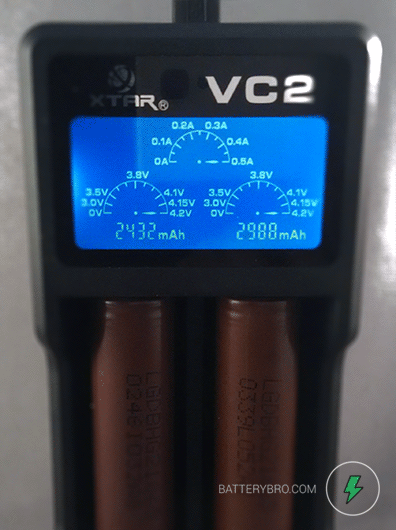
A charger like the VC2 can quickly tell you if a cell does not have the right capacity.
Thanks for reading!
Feel free to comment with your own results
If you find our results controversial, have questions, or have spotted something we haven’t please let us know in the comments. If you have inspected your own HG2 cells, please post your findings below to help others which come across this information.
Image usage rights
If you would like to use any of the images presented here on your own blog, website, or social media please feel free. All we ask is that you provide a link back to our website.
A special thanks to Daniel Tok from InnoVape who let us use his images of a fake HG2 for this blog post.
Visual Inspection & Basic Measurements

Here is the top-cap, or positive terminal of the HG2. Note there are four top-cap connection points on LG 18650 batteries.
There should be no rust, discoloration, spots, burn-marks, excessive scratch marks, or anything else out of the ordinary. As this cell has been recently produced (Summer 2015 batch), they are new and the steel will reflect that. If your new HG2 has any of the abnormalities listed above, request a return with your vendor and suspect a counterfeit battery.

This is the negative terminal, or bottom of the LG HG2. Nothing abnormal here. There are a few scratch marks (usually circular) on the bottom even on brand new cells. This is normal and from production, as the cells are tested and charged and the steel scratches easily.

Height: 65.1mm — check. (Do not do this with metal calipers as you may short-circuit the cell.)

Width: 18.5mm — no problems here. If you are making a pack, note they are a little bigger than 18mm.

Weight: 44.86g. Let’s call it 45g from measurement error. Where does that leave us? With a max. specified weight of 48g — it leaves us just fine. Albeit I will weigh a few more later just to confirm, a 3 gram discrepancy from maximum value does not cause alarm.
Discharging the LG HG2

Accounting for the test’s environmental temperature. This is five points off an ideal temperature (LG Chem’s test opted for 25 degrees C), but at this difference the efficiency loss is negligible and I will go ahead.

I enjoy charging my 18650 batteries on the VC2. The big display just makes my life better.

This is our 18650 discharging unit. The readout is volts (that last digit is a V and not a U if you were wondering). As you can see this battery is running out of juice, and the discharge test is almost complete. This unit runs off of USB power and as such it has an unfortunate current limit of 3A.
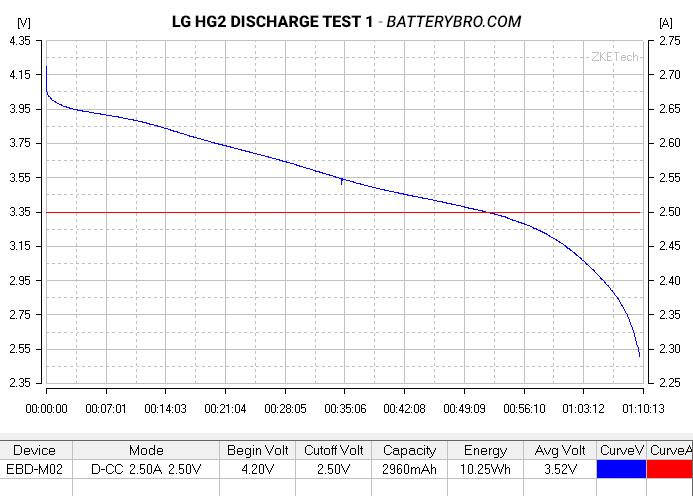
For the first discharge test I used a 2.50 amp current with a cut-off voltage of 2.50V. The capacity is 40mAh hours short of the rated capacity of 3000mAh. Does this mean the battery is not meeting its rated stats?
Yes and no.
Here’s what I mean.
The Yes
For one, the cell in this test is a few months old. A lithium-ion battery will lose some capacity every month it sits in storage. When we are concerned about 40mAh, some of that is attributed to its age.
I could also tweak my testing environment to fit LG’s testing conditions by:
- bring down cut-off voltage
- change the environmental temperature
- change amp discharge rate
- reduce the charging rate
- match end current
The No
Having said that, calling this a true 3000mAh battery is stretching the truth. It is more accurately stated as a 2960mAh battery.
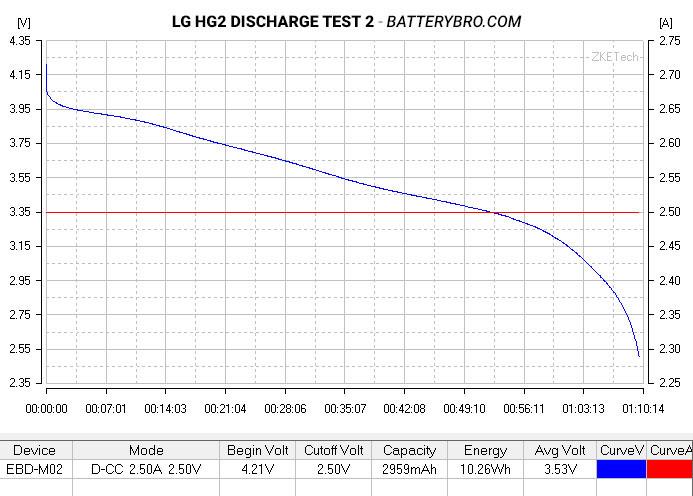
Discharge test two confirms the HG2 capacity at ~2960mAh.
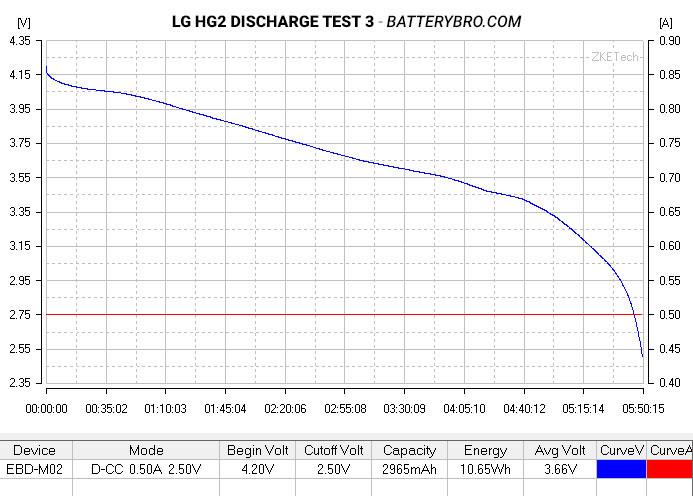
For discharge test three I changed the current to 0.50A. As you can see, at lower amperage discharges, the capacity goes up. (In this case, about 6 mAh were gained).
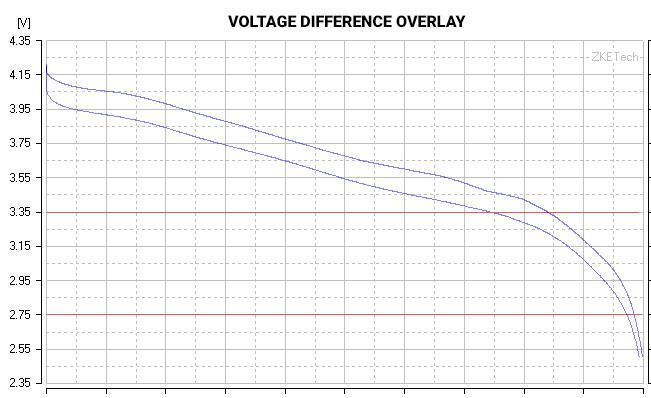
In this image I overlapped the 2nd (2.5A) and 3rd (0.50A) discharge test so you can see what is really going on.
If you look at the bottom-right of the chart, the difference along the X-axis (mAh) is small.
However the Y-axis of Voltage shows a bigger difference. You can think of this as the batteries lasting about the same amount of time, but the low amperage one gaining more working power. A higher voltage for longer results in more watt hours. The watt-hour rating can be argued as just as important as the capacity (mAh) rating.
Overview
A post on the HG2 is long overdue.
While the original release of the LG HG2 was in 2014, production has become available in Summer 2015. A 20 amp, 3000 mAh milestone is, in some way a holy grail of stats. A battery that can both be high-drain, and high-capacity is just what everyone wants. The LG HG2 can be seen as a 500mAh capacity upgrade from its predecessors the HE2/HE4 which also have a 20A discharge limit.
LG Chem is on a rolling schedule of releases and research, all planned years in advance. An average of between 6% and 10% increase in battery performance is expected, compounding yearly. That means, taking into account the battery specs and LG Chem’s release schedule, the LG HG2 will likely be a good contender for one of the best 18650 batteries for some months to come for high-drain applications.
That said, there are many cases where the newest 18650 battery with the latest specs never gains mass adoption. That can be due to a number of reasons including a quick upgraded release, unforeseen safety problems, supply chain insecurity, market ignorance, and so forth. It’s for that reason I am not crowning the HG2 as the new king on specs alone.
To test that claim, I’ll do the standard Battery Bro review:
- Take a look at the HG2 specification sheet
- Visually inspect the battery
- Do three discharge tests
- Unwrap the battery
- Determine whether the HG2 deserves a noble title
description
The LG HG2 is a very popular lithium-ion cell as it boasts some of the best specifications available today. It is intended for use in high capacity high current 18650 battery packs. It can power a wide range of devices including a cordless phone, impact wrench, or electric sprayer.
LG 18650 batteries are highly regarded for performance and safety.
The HG2 ships from Korea or Hong Kong to anywhere in the world. Our facility in Dongguan, China provides additional services such as cell assembly into battery packs, testing, or the addition of nickel tabbing, wiring, or other accessories.
This product is protected by warranty covering authenticity, performance, age, and defects.
HG2 Spec Sheet

My comments on the HG2 specification sheet:
2.1 Capacity
3,000 milliamp hours is the highest capacity ever for a true high-drain (20A+) cell. If you are interested in maximizing both amperage and capacity you should consider this cell because it doesn’t get better at the moment.
2.2 Nominal Voltage
This is the standard voltage for all 18650 batteries. (3.7V 18650 batteries are older, a standard of measurement was changed but actual voltage remains the same.)
2.3.1 Standard Charge
A 1.5A standard charge is good.
2.3.2 Fast Charge
A 4A fast charge is also good. However keep in mind that fast charging will decrease the cycle life of the HG2.
2.4 Max. Charge Voltage
Standard, no comment
2.5 Max. Change Current
N/A
2.6.1 Standard Discharge
These are normal standard discharge values. The nominal capacity of the HG2 is determined while discharging at these values. When discharging at its max. continuous discharge rating the capacity will be slightly reduced (watt hours more so).
This has likely led to the claims that the HG2 under performs. However many of these tests neither distinguished between the standard discharge vs. max. discharge testing conditions, nor did they take into account fast discharging conditions outlined by LG Chem in the spec sheet (see next section).
2.6.2 Fast Discharge
The Fast discharge has been tested at both 10A and 20A. What is important to note is the cut-off voltage of 2.0V. LG Chem’s testing conditions for rating Fast and Max. discharge values are as follows:
Cells shall be charged at constant current of 4000mA to 4.2V with end current of 100mA. Cells shall be discharged at constant current of 10000mA and 20000mA to 2.0V. Cells are to rest 10 minutes after charge and 30 minutes after discharge.
2.0V is considered the lowest possible safe cut-off voltage for discharging any 18650 cell. Most 18650 cells cut-off at 2.5V. This 0.5V difference translates to a higher milliamp hour rating, but at expense of utility. (We see a similar parallel between the LG HE2 and HE4 fast discharge conditions).
Most people do not want to go below 2.5V for safety concerns, and if they do the low voltage environment does not provide ideal performance.
2.7 Max. Discharge Current
A 20 amp cell — very good.
Note that this is the cell’s maximum continuous discharge rating. Some people seek pulse ratings, which are often fabricated.
Remember: a pulse is defined as current over time. Without stating time, pulse lacks meaning. An example of a proper pulse rating would be 30 amps for 2 seconds. A cell rated at anything above 30A, without an attached unit of time is, in essence meaningless. None of the big three (Panasonic, LG, Samsung) make an 18650 battery rated at over 30A.
2.7 Weight
(Maximum weight)
2.9 Operating Temperature
Standard, no comment
2.10 Storage Temperature
Standard, no comment
Never charge below freezing (important for the solar readers: always keep your batteries in a temperature controlled environment.)

